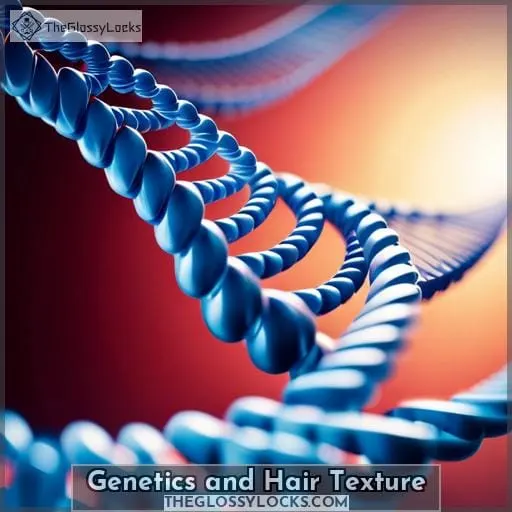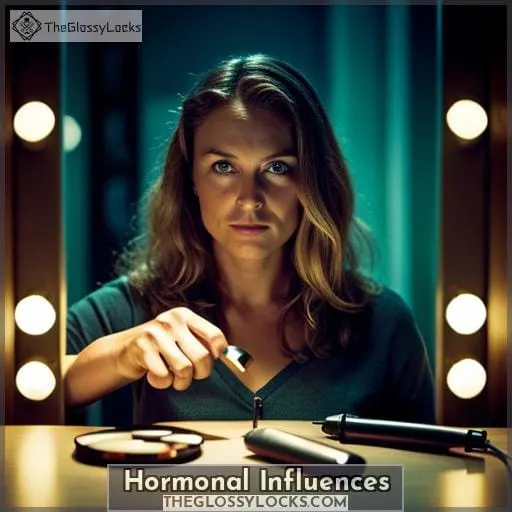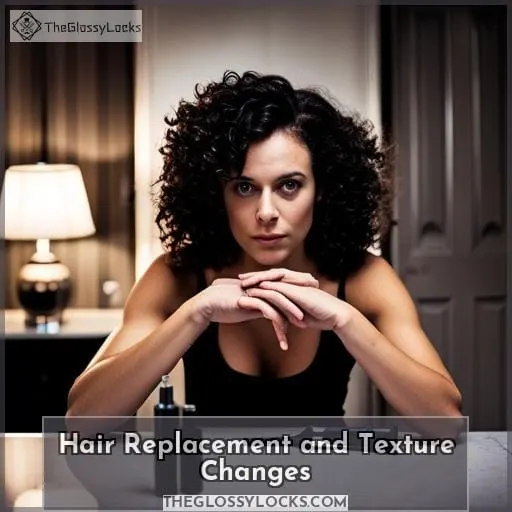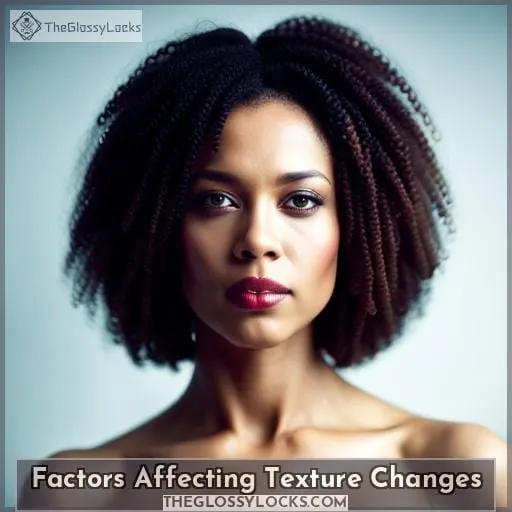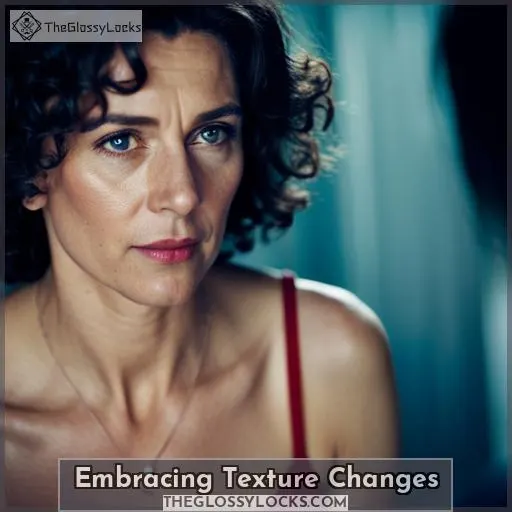This site is supported by our readers. We may earn a commission, at no cost to you, if you purchase through links.
 Ever wondered why your hair suddenly changes texture from curly to straight? You’re definitely not alone. Many people experience a change in their hair texture as they age, due to genetics or hormonal fluctuations during puberty and pregnancy.
Ever wondered why your hair suddenly changes texture from curly to straight? You’re definitely not alone. Many people experience a change in their hair texture as they age, due to genetics or hormonal fluctuations during puberty and pregnancy.
Even factors like heat styling, product buildup, and nutritional deficiencies can affect the health of our locks – resulting in changes that can make them curlier or straighter than before.
Table Of Contents
- Key Takeaways
- Genetics and Hair Texture
- Hormonal Influences
- Hair Replacement and Texture Changes
- Factors Affecting Texture Changes
- Heat Styling and Tight Hairstyles Can Stretch Out Curls
- Product Buildup Can Weigh Down Hair and Cause Frizz
- Hormonal Changes During Puberty and Pregnancy
- Nutritional Deficiencies and Health Issues Can Affect Hair
- Aging and Chemical Processing Can Alter Hair Texture
- Genetics Can Play a Role in Texture Changes
- Caring for Hair From Inside Out
- Embracing Texture Changes
- Further Research and Understanding
- Frequently Asked Questions (FAQs)
- Can I go from straight hair to curly hair? Most information focuses on curly to straight changes.
- Does dyeing or highlighting hair cause texture changes? Chemical processing is noted as a cause, but specifics not provided.
- How long does it take for texture changes to occur? The timeline for changes is not specified.
- What’s the connection between graying hair and texture? Graying is a common age-related change not covered.
- Are historical hair care practices like tight braiding linked to texture changes? Specific styling practices are not addressed as causes.
- Conclusion
Key Takeaways
- Genetic makeup determines curl shape based on follicle shape.
- Changes in curl pattern can occur over time due to genes.
- Tight hairstyles and heat damage can alter the natural curl pattern.
- Hormone fluctuations during puberty or pregnancy affect hair texture.
Genetics and Hair Texture
You may have wondered why hair texture changes, and one key factor is genetics. The shape of the follicle below the skin determines the curl shape above, and oval follicles lead to curly hair.
Shape of Follicle Determines Curl Shape
You, with your genetic makeup, have an oval follicle that forms the basis of your curl shape. Heat styling and tight hairstyles can damage curls over time, while product buildup from silicones and waxes can weigh down hair.
The natural curl pattern is also affected by hormones, as well as vitamins and minerals in the diet.
Oval Follicles Lead to Curly Hair
People with oval follicles tend to have naturally curly hair that can change over time due to environmental factors and lifestyle choices. Heat damage, product buildup, the weight of long hair, hormonal changes, and regular trims all affect the shape of your follicles, which creates a unique texture switch.
To embrace your natural curls, try protective styles like braids or buns. Also, ensure you get enough vitamins and minerals in your diet for healthy growth! Taking care from the inside out is essential if you want long-lasting natural texture.
Hormonal Influences
You may be aware that hair texture can change over time, and one potential factor is hormones. Hormones fluctuate during puberty and pregnancy, which has been hypothesized to cause changes in the texture of hair.
While there is no definitive evidence yet linking these hormonal fluctuations to shape changes in the follicle itself, it remains a logical explanation for why some people’s curl patterns have shifted from curly to straight.
Hormone Fluctuations During Puberty and Pregnancy
Hormone triggers during puberty and pregnancy can influence your hair texture over time. This may be caused by a change in follicle shape, resulting in different curl patterns. To keep your locks strong and healthy, try to avoid tight updos or buns, as well as continuous thermal styling, which can weaken the strands.
Balance hormones with nutrition-rich foods like salmon for healthier curls, while avoiding products that weigh them down, like silicones or waxes; these will stretch out the curls over time.
Hypothesized to Cause Texture Changes
Though it’s yet to be proven, many theorize that fluctuations in hormones may cause your tresses to transform from bouncy ringlets into glossy strands. To mitigate any texture effects, diet quality and hormone balance are key. Avoiding heat damage and tight hairstyles is also important for hair replacement down the line! Protein-rich foods can help create stronger hair strands while avoiding brittleness or increased body hair growth caused by big doses.
Hair Replacement and Texture Changes
You may not realize that your hair texture can change over time, even from curly to straight. This is due in part to the continuous hair replacement process: as new follicles replace old ones, different shapes can lead to changes in the overall texture of your locks.
In particular, an oval shape has been linked with a higher likelihood of developing curls, whereas those with rounder-shaped follicles have straighter strands.
Continuous Hair Replacement Process
You may be surprised to learn that your hair is constantly replacing itself, and with the introduction of new follicles comes a distinct possibility for texture changes. During the hair follicle’s growth cycle, new hair pushes out the old, changing the curl pattern based on alterations in that follicle’s shape.
Different chemicals, hormones, and oils impact these follicles over time, so hair health and type evolves in ways we don’t fully understand yet.
Different Follicle Shape Can Change Hair Texture
Discovering why your hair has changed texture can be a mystery, but its new shape could be due to the follicle’s altered shape below the surface.
- Hormone fluctuations that impact curl pattern and strength.
- Heat styling or product buildup, which weigh down locks and stretch out curls over time.
- Nutritional deficiencies or health issues causing damage to unruly hair, disrupting its natural pattern of growth.
Styling products such as creams, custards, and serums have all been known to alter hair textures long term when used regularly without proper care for strands underneath – leading them away from their original state! However, with patience and dedication, it is possible to bring back your hair’s former glory along with embracing its unique beauty in whatever form you find yourself in now!
Factors Affecting Texture Changes
You may not be aware of the multiple factors that can affect your hair texture. Heat styling and tight hairstyles can stretch out curls, while product buildup on the scalp weighs down strands and causes frizz.
Hormonal changes during puberty or pregnancy, nutritional deficiencies, health issues, as well as aging and chemical processing such as perms or relaxers, can all alter hair texture in different ways.
It is also important to consider genetic influences when it comes to why curly locks become straighter over time.
Heat Styling and Tight Hairstyles Can Stretch Out Curls
Heat styling and tight hairstyles can stretch out your curls. Think twice before committing to these looks. Balding control, texture switch, curl control? Using a combination of hydrating oils and butters like coconut oil and argan oil can help lock in moisture, heat protection is key, as well as hair health from deep conditioning to limit excessive pulling.
Product Buildup Can Weigh Down Hair and Cause Frizz
Product buildup can weigh down your locks and lead to frizzy results, so make sure you keep it light! Silicone buildup, heat damage, and curl stretching are tell-tale signs of product build-up. Clarifying shampoos to remove sticky residue are key; the main culprits include hair loss, vitamin deficiencies, and changing hair pattern.
Hormonal Changes During Puberty and Pregnancy
Hormonal changes during puberty and pregnancy can drastically affect your hair texture. Skin shape, hormone levels, hair length, and birth control all play a role in the transformation process. Chemical processing, hormone surges at puberty or pregnancy may also cause shifts to straighten curls.
Nutritional Deficiencies and Health Issues Can Affect Hair
Your body needs vitamins and minerals for locks to look luscious. A lack of them can cause changes in curl patterns.
Aging and Chemical Processing Can Alter Hair Texture
As your mane grays, those silky ringlets may lose their bounce. Years of coloring and perms take a toll too, stretching out your coils.
- Scalp health changes reducing sebum production;
- Hair breakage from much-loved products; or
- Heat protection lacking for texture shift.
Hormonal shifts plus general health impact hair follicle’s growth cycle with significant texture change potential – embrace the beauty!
Genetics Can Play a Role in Texture Changes
Your genetic code can influence how your locks look, from waves to kinks. Puberty effects and hormonal birth control may cause texture switch. Curl pattern is determined by the hair’s follicles; new science shows internal factors also play a role in texture change.
Caring for Hair From Inside Out
To keep your hair looking its best, it’s important to take care of yourself from the inside out. Eating a balanced diet full of vitamins and minerals is essential for healthy hair growth. It’s also important to get enough sleep and manage stress levels. If you don’t have the right foods in your body or aren’t sleeping enough, this can lead to certain changes in texture over time.
For example, you may experience thinning or brittle strands that won’t hold their shape. Additionally, hormone fluctuations can cause an alteration in follicle structure beneath the skin, which may result in different hair textures on different days.
Embracing Texture Changes
Rather than trying to control your hair texture, it’s important to focus on the health of your strands.
Focus on Hair Health Rather Than Controlling Style
Focus on nourishing and nurturing your locks, rather than trying to control the shape or style – ironically revealing that true beauty lies in embracing what you can’t change.
- Nourish with natural texture-friendly products, nutrition basics such as sweet potatoes and avocados.
- Avoid heat styling whenever possible; it’s a worst offender for damaging curl pattern over time!
- Consider chemical processing only when necessary; often hybridized work options are available to suit you best!
- Sleep on silk pillowcases (they help hair retain moisture)
- Devote yourself to regular self-care routines – the key is looking after your hair from within first!
We all have unique textures which require different levels of care – love yours by celebrating its individualistic nature instead of denying its power through controlling styles or treatments that could damage its delicate structure further.
Embrace and Appreciate Natural Hair Texture
Appreciate the beauty of your locks and celebrate their unique texture – allowing them to show off their natural splendor, rather than trying to change or control it.
Managing expectations, handling comments from others with a relaxed attitude, and establishing helpful self-care habits are all great ways to embrace your hair’s natural texture.
Look for styling inspiration in communities that support you no matter what; whether dry, limp, lifeless, lacking volume, or frizzy, impossible curls!
Embrace yourself just as you would a dramatic haircut – don’t be afraid of being different!
With an open mind and positive outlook, discover the real potential of embracing your own individualistic nature instead.
Further Research and Understanding
It’s clear that there are limited explanations for why hair texture changes from curly to straight. More research is needed to better understand the genetic and hormonal factors at play in these transitions.
To gain a deeper insight into this phenomenon, we must explore current theories regarding hormones and genetics, as well as the impact of lifestyle choices on our hair health.
Limited Explanations for Texture Changes
Though there are limited explanations for why hair texture changes, it’s important to remember that you can’t control the shape of your strands – but with proper self-care and nutrition, you can ensure their health.
- Genetics and environment both play a role.
- New approaches embrace natural texture.
- Focus on health and self-acceptance.
Embracing natural beauty and identity requires a journey of self-acceptance. With a solid hair care routine focused on health rather than control, damaged parts can be strengthened.
More Research Needed to Understand Genetic and Hormonal Factors
You’ll discover more about what shapes your strands as research uncovers genetic and hormonal influences. While your hair’s texture journey has molecular changes, environmental effects, and diet influences, focus on scalp health with secret ingredients and lifestyle tips.
Related blog posts share experiences and advice. Your hair reflects your identity, so embrace its natural beauty.
Frequently Asked Questions (FAQs)
Can I go from straight hair to curly hair? Most information focuses on curly to straight changes.
Unfortunately, going from straight hair to naturally curly hair isn’t possible without a perm. However, you can fake curls or waves with rollers, curling irons, or other styling products. Ultimately, hair texture is determined by genetics. The best approach is to learn to embrace your natural hair.
Does dyeing or highlighting hair cause texture changes? Chemical processing is noted as a cause, but specifics not provided.
Dyeing or highlighting should not directly alter texture. However, the chemicals can damage and dry hair over time, indirectly causing changes in curl pattern.
How long does it take for texture changes to occur? The timeline for changes is not specified.
It depends on the person, but typically, texture changes occur over several months. Your hormones and genetics play a role in how quickly you’ll notice shifts. Environment, health, age, and chemical processing can all affect your hair’s natural curl pattern too.
What’s the connection between graying hair and texture? Graying is a common age-related change not covered.
Unfortunately, there’s no known connection between graying hair and changes in texture. As we age, hair grays due to reduced melanin production, while shifts in texture relate to changes in the shape of the hair follicle over time.
Are historical hair care practices like tight braiding linked to texture changes? Specific styling practices are not addressed as causes.
Your hair’s texture came bundled with your genetics—while styling habits may influence curl pattern temporarily, they don’t undo DNA’s spirals.
Conclusion
The reasons behind curly hair becoming straight are complex, but you can embrace the changes rather than fight them. While genetics, hormones, and hair renewal play roles, focus on nourishing hair from within.
Appreciate your hair’s natural beauty as life brings waves—frizz one decade, pin-straight the next. With time and research, the factors behind texture changes from curly to straight will come to light.

